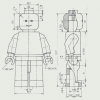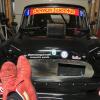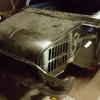No, it is extremely dangerous to adjust with the torque, so please do not use the car in that condition. You have been given very bad advice by someone lacking some basic engineering competence. That seems to be quite common with Mini ball joints for some reason.
They must be shimmed so that the condition of "no nip" (no tight spots over full angular travel) to 3 thou (near enough 0.08mm) end float is achieved at the full recommended torque. Linishing (sanding or grinding on a FLAT surface) the face of the ball retainer to make fine adjustments, if you can't get the setting exactly correct by shimming, is good, and I have done it several times. Set up correctly, and greased regularly, the joints can then last up to 100k miles.
But adjusting by torque, either the weakest point, the hub casting where the nut screws on, will be taken beyond its fatigue limit if overtightening, and will fail catastrophically some time later, or if less tight, the ball retainer will be fretting on its thread and will fail or break the locking tab and come undone, again catastrophically. And, if the joint is too tight, the shank of the ball pin fails catastrophically some time later (although I am told that sometimes the ball retainer gets ripped off its thread instead). Following anything except the procedure adequately documented in the Rover manual has killed people.
Oh, and the Rover manual shows the shims on the hub, with the locktab on top, so the ball retainer is tightening up against the relatively thick piece of metal, not a 3 thou shim. Usually, when assembled that way, the hole often does line up with the grease nipple, or come close, although some adjustment is permissible. It is not particularly wrong to put the shims on top, if it lines up better that way, but if so the thickest shim should go on top to protect the thinner ones when tightening.
In view of the considerable risks involved, if I had a ball joint that was obviously dimensionally incorrect, I would throw it away and get another. It is possibly a counterfeit part, and therefore potentially made of inferior material and dangerously weak. In fact I would throw the whole set away and get a new, properly branded set.





















